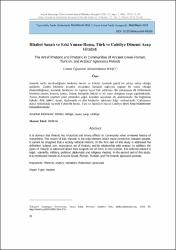Hitabet sanatı ve Eski Yunan-Roma, Türk ve Cahiliye Dönemi Arap hitabeti
Citation
Başcı, A . (2019). Hitabet Sanatı ve Eski Yunan-Roma, Türk ve Cahiliye Dönemi Arap Hitabeti . Afyon Kocatepe Üniversitesi Sosyal Bilimler Dergisi , 21 (1) , 31-48Abstract
İnsanlık tarihi incelendiğinde hitabetin önemi ve kitleler üzerinde güçlü bir etkiye sahip olduğu aşikârdır. Çünkü hitabetin insanlar arasındaki iletişimi sağlayan yegâne bir unsur olduğu düşünüldüğünde, herhalde hitabetsiz bir toplum hayal bile edilemez. Bu çalışmanın ilk bölümünde hitabetin tanımı, konusu, amacı, önemi, belagatle ilişkisi ve bir sanat olduğuna vurgu yapılmaktadır. Ayrıca hitabetin çeşitleri şekil yönünden değil, konuları açısından ele alınmaktadır. Bu bağlamda hukuki, ilmi, askerî, siyasi, diplomatik ve dini hitabetler hakkında bilgi verilmektedir. Çalışmanın ikinci bölümünde ise hitabetin genel tarihi seyrinde eski Yunanlılar ve Roma dönemi, Türklerde hitabetin -bilhassa İslam’a girdikten sonra- ilerleme kaydettiği ve meşhur hatiplerin isimleri zikredilmektedir. Genellikle Cahiliye devrinde Araplarda hitabetin zirve yaptığını belirten makale, örnek hitabelerle tamamlanmaktadır. It is obvious that rhetoric has important and strong effects on community when reviewed history of humankind. The reason of this, rhetoric is the only element which make connection between people. It cannot be imagined that a society without rhetoric. In the first part of this study is addressed the definition, subject, aim, importance, art of rhetoric, and its relationship with oratory. In addition, the types of rhetoric is addressed about their subjects not of form. In this context, it is referred related to legal, scientific, military, political, diplomatic and religious rhetoric. In the second part of this study, it is mentioned rhetoric in Ancient-Greek, Roman, Turkish, and Pre-Islamic Ignorance periods.
Source
Afyon Kocatepe Üniversitesi Sosyal Bilimler DergisiVolume
21Issue
1URI
https://dergipark.org.tr/tr/pub/akusosbil/issue/43639/409189https://doi.org/10.32709/akusosbil.409189
https://hdl.handle.net/11630/8757
Collections
- Cilt 21 : Sayı 1 [23]



















